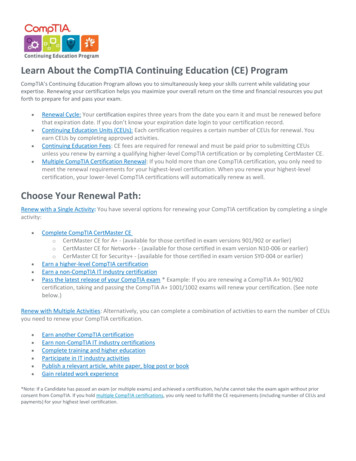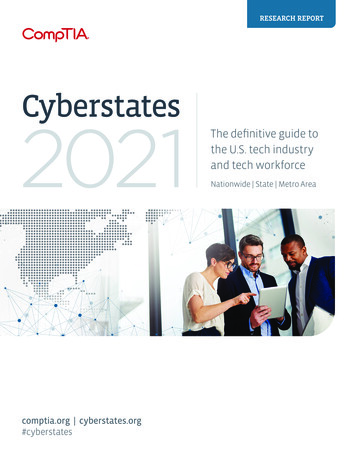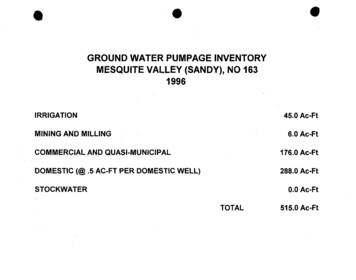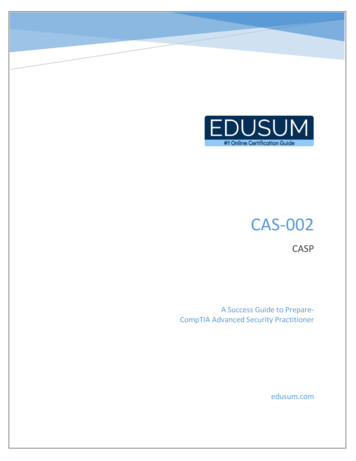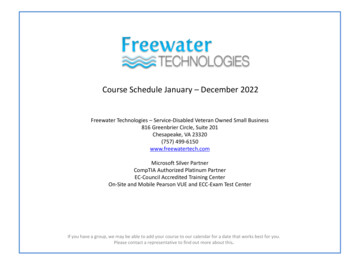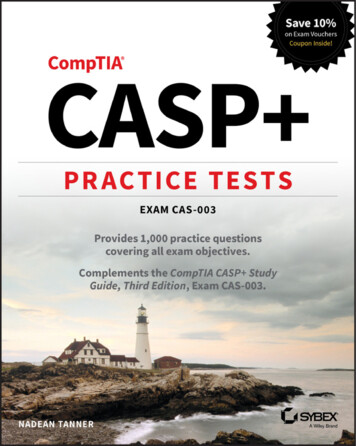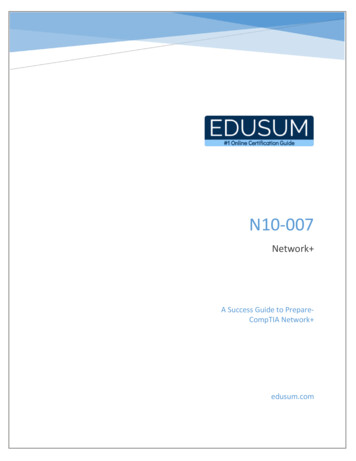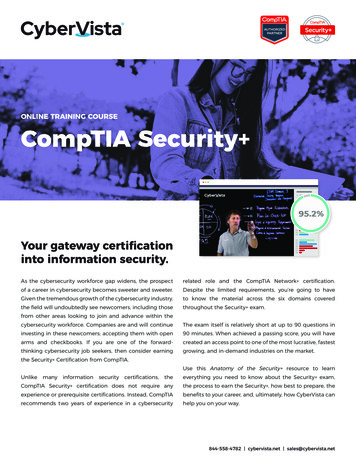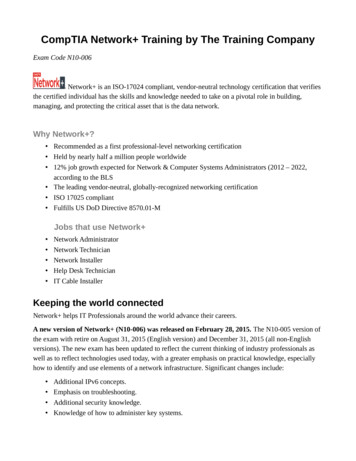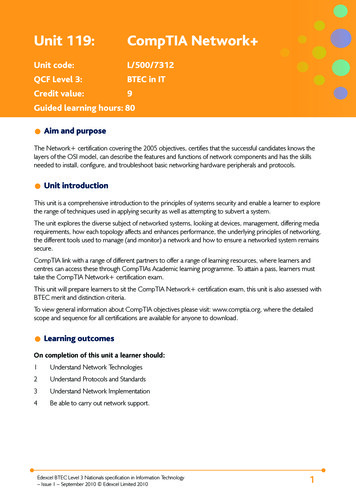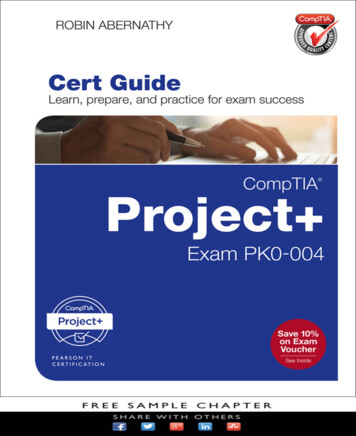
Transcription
CompTIA Project Cert GuideRobin Abernathy800 East 96th StreetIndianapolis, Indiana 46240 USA
CompTIA Project Cert GuideCopyright 2018 by Pearson Education, Inc.Editor-in-ChiefMark TaubAll rights reserved. No part of this book shall be reproduced, stored ina retrieval system, or transmitted by any means, electronic, mechanical,photocopying, recording, or otherwise, without written permission fromthe publisher. No patent liability is assumed with respect to the use of theinformation contained herein. Although every precaution has been taken inthe preparation of this book, the publisher and author assume no responsibility for errors or omissions. Nor is any liability assumed for damagesresulting from the use of the information contained herein.Product Line ManagerBrett BartowISBN-13: 978-0-7897-5883-5ISBN-10: 0-7897-5883-0Managing EditorSandra SchroederLibrary of Congress Control Number: 2017944115Senior Project EditorPrinted in the United States of AmericaTonya SimpsonFirst Printing: July 2017TrademarksAll terms mentioned in this book that are known to be trademarks or service marks have been appropriately capitalized. Pearson IT Certificationcannot attest to the accuracy of this information. Use of a term in this bookshould not be regarded as affecting the validity of any trademark or servicemark.Warning and DisclaimerEvery effort has been made to make this book as complete and as accurateas possible, but no warranty or fitness is implied. The information providedis on an “as is” basis. The author and the publisher shall have neither liability nor responsibility to any person or entity with respect to any loss ordamages arising from the information contained in this book.Special SalesFor information about buying this title in bulk quantities, or for specialsales opportunities (which may include electronic versions; custom coverdesigns; and content particular to your business, training goals, marketingfocus, or branding interests), please contact our corporate sales departmentat corpsales@pearsoned.com or (800) 382-3419.For government sales inquiries, please contactgovernmentsales@pearsoned.com.For questions about sales outside the U.S., please contactintlcs@pearson.com.Acquisitions EditorMichelle NewcombDevelopment EditorRobin DrakeCopy EditorRobin DrakeIndexerPublishing Works, Inc.ProofreaderGill Editorial ServicesTechnical EditorAnn LangPublishing CoordinatorVanessa EvansCover DesignerChuti PrasertsithCompositorBumpy Design
Contents at a GlanceIntroductionxxiPart I: Project BasicsCHAPTER 1Project Properties and Phases3CHAPTER 2Project Roles, Responsibilities, and Team StructuresCHAPTER 3Project Cost ControlCHAPTER 4Project SchedulesCHAPTER 5Personnel and Physical Resource ManagementCHAPTER 6Agile Methodology47638567Part II: Project Constraints, Influences, and RisksCHAPTER 7Project Constraints and InfluencesCHAPTER 8Risk Activities and Strategies125146Part III: Communication and Change ManagementCHAPTER 9Communication Methods and InfluencesCHAPTER 10Communication Triggers and Target AudiencesCHAPTER 11Change Control214Part IV: Project Tools and DocumentationCHAPTER 12Project Management ToolsCHAPTER 13Project Documentation273CHAPTER 14Vendor Documentation290243Part V: Getting Ready for the ExamCHAPTER 15Final PreparationAPPENDIX AAnswers to the “Do I Know This Already?”Quizzes and Review Questions 311GlossaryIndex307331354Elements Available On the Book’s WebsiteAPPENDIX B Memory TablesAPPENDIX C Memory Tables Answer KeyGlossary16819429
Table of ContentsIntroductionxxiPart I: Project BasicsChapter 1Project Properties and Phases 3“Do I Know This Already?” Quiz 3Foundation Topics 7Definition of a Project 7Temporary8Start and Finish 8Unique8Reason/Purpose 9Project as Part of a Program 9Project as Part of a Portfolio 9Project Phases 10Initiating Phase 11Project Charter 11Business Case 12High-Level Scope Definition 12High-Level Risks 12Stakeholder Register 12Planning Phase 12Schedule13Scope Management Plan 13Work Breakdown Structure (WBS) 14Scope Baseline and Scope Statement 14Resources 14Detailed Risks 14Requirements and the Requirements Management Plan 14Communication Plan 15Stakeholder Management Plan 15
Table of Contents vProcurement Management Plan 15Change Management Plan 15Budget15Executing Phase 16Monitoring and Controlling Phase 16Issues Log 16Performance Measuring and Reporting 17Quality Assurance/Governance 17Change Control 17Budget18Closing Phase 18Transition/Integration Plan 18Project Sign-Off 18Archiving Project Documents 19Lessons Learned 19Releasing Resources 19Closing Contracts 19Project Knowledge Areas 19Project Integration 20Scope Management 20Time Management 20Cost Management 21Quality Management 21Human Resource Management 21Communication Management 21Risk Management 22Procurement Management 22Stakeholder Management 22Exam Preparation Tasks 23Review All Key Topics 23Define Key Terms 23Review Questions 24
vi CompTIA Project Cert GuideChapter 2Project Roles, Responsibilities, and Team Structures 29“Do I Know This Already?” Quiz 29Foundation Topics 33Project Roles and Responsibilities 33Project Sponsor 33Project Manager 33Project Coordinator 34Stakeholder 34Scheduler35Project Team 35Project Management Office (PMO) 36Project Team Structures 36Functional Team Structure 37Matrix Team Structure 38Projectized Team Structure 40Exam Preparation Tasks 41Review All Key Topics 41Define Key Terms 41Review Questions 42Chapter 3Project Cost Control 47“Do I Know This Already?” Quiz 47Foundation Topics 50Cost Baseline 50Total Project Cost 50Expenditure Tracking and Reporting 50Cost Control Calculations 51Earned Value Management (EVM) 52Forecasting 54To-Complete Performance Index (TCPI) 56Reserve Analysis 57Change Requests 57Exam Preparation Tasks 58Review All Key Topics 58
Table of Contents viiDefine Key Terms 58Review Questions 59Chapter 4Project Schedules 63“Do I Know This Already?” Quiz 63Foundation Topics 67Work Breakdown Structure (WBS) 67Scheduling Activities 70Determine Tasks 70Determine Milestones 71Determine Task Durations and Start/Finish Dates 71Set Predecessors and Dependencies 71Sequence and Prioritize Tasks 72Determine Critical Path 72Allocate Resources 76Set Baseline 77Set Quality Gates 77Set Governance Gates 78Exam Preparation Tasks 78Review All Key Topics 78Define Key Terms 79Review Questions 79Chapter 5Personnel and Physical Resource Management 85“Do I Know This Already?” Quiz 85Foundation Topics 89Personnel Management 89Team Building and Trust Building 89Team Selection and Skill Sets 90Remote Versus In-House 91Personnel Removal/Replacement 92Communication Issues 92Conflict Resolution 94SmoothingForcing9494
viii CompTIA Project Cert GuideCompromising 95ConfrontingAvoiding9596Negotiating97Resource Management 98Shared Versus Dedicated Resources 98Resource Allocation 99Resource Shortage Versus Overallocation 100Low-Quality Resources 100Benched Resources 101Interproject Dependencies and Resource Contention 101Exam Preparation Tasks 102Review All Key Topics 102Define Key Terms 103Review Questions 103Chapter 6Agile Methodology 107“Do I Know This Already?” Quiz 107Foundation Topics 111Adaptive Planning 111Iterative and Incremental Processes 111Requirements Gathering and User Stories 112Scrum Development 113Sprint Planning 114Daily Scrum Meetings 114Continuous Feedback 115Burndown Charts 115Scrum Retrospectives 119Self-Organized and Self-Directed Teams 120Exam Preparation Tasks 120Review All Key Topics 120Define Key Terms 121Review Questions 121
Table of Contents ixPart II: Project Constraints, Influences, and RisksChapter 7Project Constraints and Influences 125“Do I Know This Already?” Quiz 125Foundation Topics 129Common Constraints 129Cost Constraint 130Scope Constraint 131Time and Scheduling Constraints 131Deliverables Constraint 132Quality Constraint 132Environment Constraint 133Resources Constraint 134Requirements Constraint 135Project Influences 136Change Requests 136Scope Creep 137Constraint Reprioritization 138Interaction Between Constraints 139Stakeholder, Sponsor, and Management Influences 140Influence by Other Projects 140Exam Preparation Tasks 141Review All Key Topics 141Define Key Terms 142Review Questions 142Chapter 8Risk Activities and Strategies 147“Do I Know This Already?” Quiz 147Foundation Topics 151Risk Activities 151Risk Planning 151Risk Identification 152Risk Quantification and Prioritization 153Risk Response Planning 154Risk Review 155
x CompTIA Project Cert GuideRisk Register 155Risk Communication 159Risk Strategies 160Accept Risk 160Mitigate Risk 161Transfer Risk 161Avoid Risk 161Exploit Risk 162Enhance Risk 162Share Risk 162Exam Preparation Tasks 162Review All Key Topics 163Define Key Terms 163Review Questions 164Part III: Communication and Change ManagementChapter 9Communication Methods and Influences 169“Do I Know This Already?” Quiz 171Foundation Topics 173Communication Methods 173Meetings173Kickoff Meetings 173Virtual Versus In-Person Meetings 174Scheduled Versus Impromptu Meetings 175Closure Meetings 175Email and Fax 176Video and Voice Conferencing 176Instant Messaging and Text Messaging 177Face-to-Face Communication 178Distribution of Printed Media 179Social Media 179Communication Influences 180Language Barriers 180Time Zones and Geographical Factors 181Technological Factors 182
Table of Contents xiCultural Differences 183Interorganizational and Intraorganizational Differences 184Personal Preferences 184Building Rapport and Relationships 185Message Content and Criticality Factors 186Stakeholder Communication Requirements 186Communication Frequency 186Level of Report Detail 187Types of Communication 187Confidentiality Constraints 187Communication Style 188Exam Preparation Tasks 188Review All Key Topics 189Define Key Terms 189Review Questions 189Chapter 10Communication Triggers and Target Audiences 195“Do I Know This Already?” Quiz 195Foundation Topics 199Audits199Project Planning 200Project Changes 201Schedule Changes 203Stakeholder Changes 204Resource Changes 204Budget Changes 205Risk Register Updates 206Milestones206Task Initiation/Completion 207Gate Reviews 207Incident Responses and Business Continuity Responses 208Exam Preparation Tasks 209Review All Key Topics 210Define Key Terms 210Review Questions 211
xii CompTIA Project Cert GuideChapter 11Change Control 215“Do I Know This Already?” Quiz 215Foundation Topics 219Change Control Process 219Identify and Document the Change 220Evaluate Impact and Provide Justification 222Develop a Regression Plan 222Identify Approval Authority and Obtain Approval 222Implement Change 223Validate Change and Check Quality 223Update Documents 223Change Communication 224Project Change Types 224Schedule Changes 225Budget Changes 227Risk Events 228Requirements Changes 229Quality Changes 229Resource Changes 230Scope Changes 231Communication Changes 231Stakeholder Changes 232Procurement Changes 232Emergency Changes 233Organizational Changes 233Business Merger/Acquisition and Demerger/Split 234Business Process Change 235Internal Reorganization 235Relocation 236Outsourcing236Exam Preparation Tasks 237Review All Key Topics 237Define Key Terms 238Review Questions 238
Table of Contents xiiiPart IV: Project Tools and DocumentationChapter 12Project Management Tools 243“Do I Know This Already?” Quiz 243Foundation Topics 247Project Scheduling Software 247Charts and Diagrams 247Process Diagram 248Histogram250Fishbone Diagram 251Pareto Chart 251Run Chart 252Scatter Chart 253Gantt Chart 256Dashboards and Status Reports 257Knowledge Management Tools 257Intranet and Internet Sites 258Wiki Pages 258Vendor Knowledge Bases 259Collaboration Tools 259Performance Measurement Tools 260Key Performance Indicator (KPI)/Key PerformanceParameter (KPP) 260Balanced Score Card (BSC) 262SWOT Analysis 263RACI Matrix 265Exam Preparation Tasks 266Review All Key Topics 266Define Key Terms 267Review Questions 267Chapter 13Project Documentation 273“Do I Know This Already?” Quiz 274Foundation Topics 277Project Charter 277Project Management Plan 277
xiv CompTIA Project Cert GuideIssues Log 279Organizational Chart 280Scope Statement 281Communication Plan 281Project Schedule 281Status Reports 282Dashboard Information 282Action Items 283Meeting Agenda and Minutes 284Exam Preparation Tasks 284Review All Key Topics 284Define Key Terms 285Review Questions 285Chapter 14Vendor Documentation 291“Do I Know This Already?” Quiz 291Foundation Topics 294Request for Information (RFI) 294Request for Proposal (RFP) 295Request for Quote (RFQ) 296Mutually Binding Documents 297Agreement/Contract 297Non-Disclosure Agreement (NDA) 299Cease-and-Desist Letter 300Letter of Intent (LOI) and Memorandumof Understanding (MOU) 300Statement of Work (SOW) 301Service-Level Agreement (SLA) 301Purchase Order (PO) 301Warranty302Exam Preparation Tasks 302Review All Key Topics 302Define Key Terms 303Review Questions 303
Table of Contents xvPart V: Getting Ready for the ExamChapter 15Final Preparation 307Take Advantage of the Tools in This Book 307Retake the “Do I Know This Already?” Quizzes 307Prepare for Vocabulary Differences on the Project Exam 307Work Through the “Exam Preparation Tasks” Sections 308Complete the Memory Tables Appendixes 309Review the Examples 309Practice with Pearson Test Prep 309Ready, Set, Test! 309Appendix A Answers to the “Do I Know This Already?” Quizzesand Review Questions 311Glossary 331Index354Elements Available On the Book’s WebsiteAppendix B Memory TablesAppendix C Memory Tables Answer KeyGlossary
xvi CompTIA Project Cert GuideAbout the AuthorRobin M. Abernathy has been working in the IT certification preparation industry at Kaplan IT Training, the owners of the Transcender brand, for more than15 years. She has written and edited certification preparation materials for many(ISC)2, Microsoft, CompTIA, PMI, Cisco, EC-Council, and ITIL certifications andholds multiple IT certifications from these vendors.Robin provides training on computer hardware and software, networking, security,and project management. She has served as technical editor for several publicationsand coauthored Pearson’s CompTIA Advanced Security Practitioner (CASP) CAS-002Cert Guide and CISSP Cert Guide, Second Edition. She also gives presentations attechnical conferences and hosts webinars on IT certification topics.
Acknowledgments xviiDedicationFor my husband, Michael, and my son, Jonas. I love you both!AcknowledgmentsFirst, I once again thank my Heavenly Father for knowing what I was meant to do,even when in my early adult years I said, “I will never work on computers or writefor a living.” God always has a plan. And I know He has a sense of humor!My life would not have been complete without my surrogate brothers. While youentered my world through tragic circumstances, you have come to be my realbrothers. Doug Carey and John Carey, thanks for introducing me to all thingsCincinnati Reds, Batman, Star Trek, and Elvis. Thanks for adopting two little sisters, which I know as teenagers must have been trying at times. Love you both!Lynne and Lorrie, we love having you in our family as well! Will Carey, BobbyCarey, Christian Carey, and Jacob Carey, you have fine fathers, and I love watchingas you become so much like them!I would like to acknowledge all my nieces and nephews, who were my surrogatechildren before God blessed me with my own child. Jordyn Abernathy, ChaseAbernathy, Chad Abernathy, Cassie Bonds, Caitie Bonds, Zack Stadler, NoahStadler, and Gabe Stadler, you were my first children, even though your parentsthink otherwise. Tyler Loggins, thanks for stepping in as an older brother to theStadler boys. And finally, Luke and Jordyn McDaniel, our family and your parentswaited a long time for you. It is our joy to watch you grow and become a centralpart of our family stories!I must thank my wonderful husband, Michael, and son, Jonas, for once again beingwilling to do “guy things” while I was locked away in the world of project management. You are my world! What a wonderful ride we are on!!!Thanks to all at Pearson for once again assembling a wonderful team to help me getthrough this Project journey. Robin Drake and Ann Lang, I honestly think this wasthe best team yet. You two are rock stars!To you, the reader, I wish you success in your IT certification goals!—Robin Abernathy
xviii CompTIA Project Cert GuideAbout the Technical ReviewerAnn Lang is a certified project manager and technical writer. She has been a technical editor for Kaplan IT Test Prep’s line of IT certification products for 10 years.Prior to working as a technical writer, she worked in public broadcasting, for a university press, and in various jobs related to her lifelong love of language.
Reader Services xixWe Want to Hear from You!As the reader of this book, you are our most important critic and commentator. Wevalue your opinion and want to know what we’re doing right, what we could do better, what areas you’d like to see us publish in, and any other words of wisdom you’rewilling to pass our way.We welcome your comments. You can email or write to let us know what you did ordidn’t like about this book—as well as what we can do to make our books better.Please note that we cannot help you with technical problems related to the topic of this book.When you write, please be sure to include this book’s title and author as well as yourname and email address. We will carefully review your comments and share themwith the author and editors who worked on the book.Email: feedback@pearsonitcertification.comMail:Pearson IT CertificationATTN: Reader Feedback800 East 96th StreetIndianapolis, IN 46240 USAReader ServicesRegister your copy of CompTIA Project Cert Guide atwww.pearsonitcertification.com for convenient access to downloads, updates,and corrections as they become available. To start the registration process,go to www.pearsonitcertification.com/register and log in or create an account*.Enter the product ISBN 9780789758835 and click Submit. When the process iscomplete, you will find any available bonus content under Registered Products.*Be sure to check the box that you would like to hear from us to receive exclusivediscounts on future editions of this product.
Introduction xxiIntroductionThe Project certification is an excellent entry-level project management certification. As a globally recognized credential, the Project certification demonstratesthat the holder has knowledge and skills across a broad range of project management topics.Every day, in every industry, organizations large and small launch new projects.Many of these organizations realize that personnel with skills and knowledge inproject management are vital to successful projects. Project certified professionals have more than just basic project management knowledge; to pass the Project exam, certification candidates must understand all aspects of project management.Project management knowledge and skills apply to all types of projects, from construction to software development to manufacturing and all other fields. EarningProject certification demonstrates the project management professional’s ability toinitiate, plan, execute, monitor and control, complete, and close projects.Goals of the Project CertificationThe Project certification is created and managed by the Computing Technology Industry Association (CompTIA), a well-known certification body. CompTIAProject certification has a number of stated goals. Although not crucial for passing the exam, having knowledge of the CompTIA organization and its goals for theProject certification can be helpful in understanding the motivation behind thecreation and contents of the exam.Sponsoring BodyCompTIA is a nonprofit trade association that provides a vendor-neutral certification process and works with partners to create educational materials. The Project certification is one of a number of certifications offered by CompTIA: A Network Security Linux Cloud Mobility Server CDIA
xxii CompTIA Project Cert GuideCompTIA also offers two master-level security certifications: CompTIA Advanced Security Practitioner (CASP) Cybersecurity Analyst (CSA )Stated GoalsThe goal of CompTIA in its administration of the Project certification is toprovide a reliable instrument to measure an individual’s knowledge and skills formanaging the project life cycle, ensuring appropriate communication, managingresources and stakeholders, and maintaining project documentation. The topicscovered in the exam are technically more shallow than those tested by some otherproject management certifications.The topics that comprise the four domains of knowledge covered by the Project exam (PK0-004) are discussed later in this Introduction.Value of the Project CertificationThe Project certification holds value for both the exam candidate and the organization. Project management is a job skill that is increasing in popularity on job sites.Project is often seen as a great entry-level certification for people who are new tothe project management field.To the Project ProfessionalMany reasons exist for a project management professional to spend the time andeffort required to achieve Project certification: To meet growing demand for project management professionals To become more marketable in an increasingly competitive job market To enhance skills in a current job To qualify for or compete more successfully for a promotion To increase earningsIn short, this credential demonstrates that the holder not only has the knowledgeand skills tested on the exam but also the wherewithal to plan and implement acourse of study that addresses a broad range of project management topics.
Introduction xxiiiTo the OrganizationFor an organization, the Project certification offers a reliable benchmark againstwhich job candidates can be measured by validating both knowledge and experience.Individuals holding this certification stand out, making the hiring process easier andadding a level of confidence in the final selection.Project ObjectivesThe material contained in the Project exam (PK0-004) is divided into fourdomains, with several objectives in each: Project basics domain Project constraints domain Communication and change management domain Project tools and documentation domainFor the most part, this book devotes a chapter to each of these objectives. A fewobjectives have been combined logically into one chapter. Some overlap is inevitablebetween the domains and objectives, leading to some overlap between topics covered in the chapters. This section describes the domains and topics covered.Project Basics DomainThe project basics domain covers a broad spectrum of general project managementtopics: Properties of a project Project roles and responsibilities Project phases Project cost control Project team organizational structures Project schedules Agile methodology Human resource, physical resource, and personnel management
xxiv CompTIA Project Cert GuideProject Constraints DomainThe project constraints domain covers a broad range of project limiting factors: Project constraint variables and influences Project risk strategies and activitiesCommunication and Change Management DomainThe communication and change management domain covers the who, what, why, andwhen of communication and the change management process: Project communication methods Project communication influences Project communication triggers, audience, and rationale Project change control process and types of changes Organizational changeProject Tools and Documentation DomainThe project tools and documentation domain covers all the tools and documents that areused to manage a project successfully: Project management tools Project-centric documents Vendor-centric documentsSteps to Becoming CompTIA Project CertifiedTo become CompTIA Project certified, the candidate must meet certain prerequisites and follow certain procedures. This section covers those topics.About the Project ExamThe Project exam is a computer-based test that the candidate can spend up to 90minutes completing. There are no formal breaks, but you are allowed to take shortbreaks. Any time used for breaks counts toward the maximum cumulative time of135 minutes, whether you take the test online or in person at a Pearson VUE authorized testing center. You must bring a government-issued identification card. Noother forms of ID are accepted.
Introduction xxvThe test will have up to 100 multiple-choice questions and drag-and-drop questions.The passing grade is 710 out of a possible 900. Candidates will receive the results atthe test center from the test administrator.Qualifying for the ExamWhile there are no experience requirements for taking the exam, CompTIA recommends at least 12 months of cumulative project management experience. Becausethis is not a requirement, candidates can sign up for the exam without this experience, but should spend adequate study time to ensure that they have the knowledgeneeded for this exam.Signing Up for the ExamCompTIA exams are offered at Pearson VUE testing centers around the world.Certain qualified students or other individuals in the U.S. and Canada may be eligible to take the Project exam remotely through ProctorU instead of visiting a testing center. If you want to take the exam online, review the requirements and followthe instructions at http://proctoru.com/portal/comptia.The steps to sign up for the Project exam at your local Pearson VUE testing centerare as follows:1. Create a Pearson VUE account (www.pearsonvue.com/comptia).2. Schedule your exam at your nearest Pearson VUE facility.3. Save your exam appointment confirmation.After you complete the exam, you will be given a score report. Save this scorereport until you confirm that you have been awarded the credential by logging .How To Use This BookThe goal of this book is simple: Helping you to pass the 2017 version of theCompTIA Project Certification exam (PK0-004).The Project exam stresses a complete understanding of the knowledge areas andexperience of project management. Whether you have an extensive background as aproject manager in multiple industries, or you are entering the project managementfield for the first time, this book is designed to help you understand and master therequired objectives for the exam.
xxvi CompTIA Project Cert GuideThis book uses several methodologies to help you 1) discover the exam topics onwhich you need more review, 2) fully understand and remember details about thosetopics, and 3) prove to yourself that you have retained your knowledge of those topics. To pass the exam, memorizing terminology is not sufficient; you must understand the concepts covered in the exam and this book.Each chapter is structured in the following way: Objectives: The chapter opens with a list of Project exam topics covered inthe chapter, a brief introduction to those topics, and a list of the corresponding CompTIA Project objectives. “Do I Know This Already?” Quiz: This quiz tests your knowledge and understanding of the main topics covered in the chapter. Detailed answers are inAppendix A, “Answers to the ‘Do I Know This Already?’ Quizzes and ReviewQuestions.” The quiz helps you to assess whether you should read the entirechapter, read only the sections on unfamiliar topics, or jump immediately tothe “Exam Preparation Tasks” section. Foundation Topics: This section holds the core content of the chapter. Itexplores the chapter topics with both theory and examples. In-depth descriptions, lists, tables, and figures are geared to build your knowledge so that youcan pass the Project exam. Examples: This book presents more than 125 true-to-life examples thatdemonstrate how project management actually works in the phases, tasks,documents, processes, etc. that are part of the project manager’s job. Theseexamples are designed to give you real-world insight that is particularly usefulin scenario-based questions on the live Project exam. Key Topics: The Key Topic icon in the margin indicates important informa-tion that you should know for the exam. Although the contents of the entirechapter could be on the exam, you should definitely know the informationlisted in each key topic. All of the key topics for the chapter are gathered in aKey Topics table at the end of the chapter for quick reference to the text covering each key topic. Exam Preparation Tasks: This section of the chapter moves from activelearning to active exam preparation. Now that you have grasped the chaptercontents, use the activities in this section to test your understanding of theinformation in the chapter: Review All Key Topics: The Key Topics table in this section providesa brief summary of each chapter element marked with the Key Topicsymbol described earlier. Review the contents of this table carefully tocheck your understanding of that topic. In case you need to refresh your
Introduction xxviimemory or learn more, the table lists the corresponding page numberwhere each topic begins, so you can jump instantly to that point in thechapter. Define Key Terms: This section lists all the important terms discussed inthe chapter. You are expected to be familiar with these key terms for theProject exam. Provide your own definitions for the terms in the list, andthen compare your definitions against those in the Glossary at the end ofthe book. The Glossary combines all the key terms from all the chapters,listed alphabetically to make each term easy to find. Review Questions: Each chapter ends with 10 multiple-choice questions,designed to test your knowledge of the chapter content. Check yourselections against the answers and descriptions in Appendix A.Who Should Read This Book?The CompTIA Project examination is designed for project management in anyfield. The exam certifies that the successful candidate has the requi
viii CompTIA Project Cert Guide Compromising 95 Confronting 95 Avoiding 96 Negotiating 97 Resource Management 98 Shared Versus Dedicated Resources 98 Resource Allocation 99 Resource Shortage Versus Overallocation 100 Low-Quality Resources 100 Benched Resources 101 Interproject Dependenci

